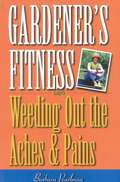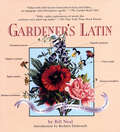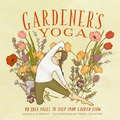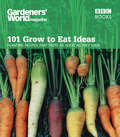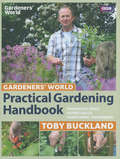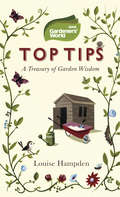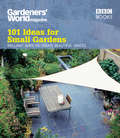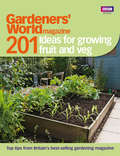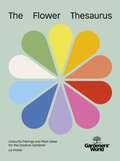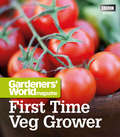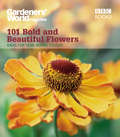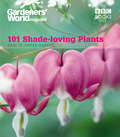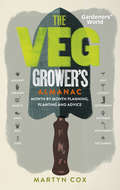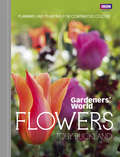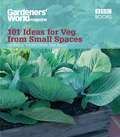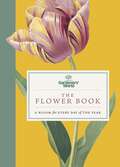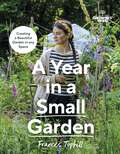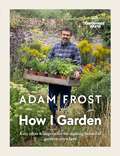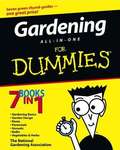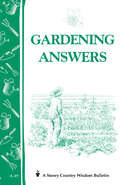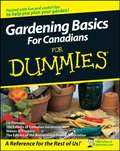- Table View
- List View
Gardener's Fitness: Weeding Out the Aches and Pains
by Barbara PearlmanA practical, easy-to-follow manual, Gardener's Fitness includes conditioning exercises, postural guidance for moving correctly and safely, therapeutic stretches to relieve discomfort, and a variety of gentle exercises designed to relax tired muscles and restore energy after laboring in the garden.
Gardener's Latin: A Lexicon
by Bill Neal Barbara DamroschFor more than a decade, gardeners have been turning to a beautiful little hardcover book called Gardener's Latin, by Bill Neal. Neal understood that as Latin terms began appearing with increasing frequency on nursery tags and gardening catalogs, gardeners would need help. So he weeded through the Latin words that describe and distinguish among plants and flowers and compiled a volume of select, brief, clear definitions.Gardener's Latin leads us down the path from abbreviatus to zonatus, turning aside here and there along the way for little-known horticultural facts and fables and the wisdom ofgardeners from Virgil to Vita Sackville-West.
Gardener's Yoga: 40 Yoga Poses to Help Your Garden Flow
by Frida Clements Veronica D'OrazioHere are 40 yoga poses specifically designed for gardeners' bodies and spirits to stretch, relax, and grow through the seasons. With the right sequence of yoga poses, a gardener's body can bend with the wind and stretch to the sky to alleviate the aches that come from all that digging, pulling, and carrying. In this beautifully illustrated book, yoga poses are divided into seasonal sequences--or flows--each addressing the gardener's body, the state of the garden, and the natural world. The practice of yoga aligns perfectly with gardening in its motions, metaphors, and calming effects.From the Trade Paperback edition.
Gardeners' World - 101 Ideas for Pots: Foolproof recipes for year-round colour
by Ceri ThomasYou don't even need a garden to enjoy growing beautiful plants as a pot or window box can be squeezed in anywhere. Whether you want to have colourful flowers or homegrown veg, Gardeners' World 101 Pots is packed with fantastic planting recipes to try. All are easy to do and will produce great results without any hassle. There are ideas to create stunning displays for each season of the year, plus easy ways to grow veg in pots so your own homegrown produce is just outside your kitchen.You'll never be stuck for ideas of what to plant with this handy little book.Gardeners' World Magazine is Britain's biggest selling gardening magazine, providing fresh ideas and clear advice every month. From plants and flowers to gardens and design, allotments and kitchen gardens to shopping guides and tried and tested reviews, Gardeners' World Magazine features the top names in BBC gardening, such as Monty Don, Alan Titchmarsh, Carol Klein and the Gardeners' Question Time team. Find out more at www.gardenersworld.com
Gardeners' World 101 - Grow to Eat Ideas: Planting recipes that taste as good as they look
by Ceri ThomasThere's nothing better than the taste of home-grown fruit and veg. It has flavour and freshness that no supermarket produce could ever hope to beat. Whether you've grown your own all your life or are just getting into gardening, Gardeners' World 101 Grow to Eat Ideas is packed with inspiration. There are ideas for growing salads, fruit, herbs and vegetables. You don't even need a garden to enjoy our planting recipes for pots that taste as good as they look as they'll do equally well on a windowsill as a patio.You'll never eat tasteless fruit and veg again with Gardeners' World 101 Grow to Eat Ideas.Gardeners' World Magazine is Britain's biggest selling gardening magazine, providing fresh ideas and clear advice every month. From plants and flowers to gardens and design, allotments and kitchen gardens to shopping guides and tried and tested reviews, Gardeners' World Magazine features the top names in BBC gardening, such as Monty Don, Alan Titchmarsh, Carol Klein and the Gardeners' Question Time team. Find out more at www.gardenersworld.com
Gardeners' World Practical Gardening Handbook: Innovative Ideas, Expert Skills, Traditional Techniques
by Toby BucklandIn this brilliant official companion to Gardeners' World, lead presenter Toby Buckland offers a complete guide to making you a better gardener.Toby sees the garden as connected to the kitchen, the compost heap and the world beyond. He encourages us to turn gardening into an adventure rather than a list of chores. It becomes a workshop to fashion an apple press from skip-scavenged timber, or a warm greenhouse sanctuary. Borders aren't just for weeding, they're for strawberries by the punnet-load. Piles of golden leaves along the roadside aren't just the soggy debris of autumn but the potential for soil-enriching leaf mould. Opening our eyes to these connections helps us appreciate the joy of gardening, and this book teaches you the craft. However big or small your plot, whether you are starting from scratch or looking for new ideas to refresh an established scheme, the Practical Gardening Handbook will show you how to bring your garden alive.
Gardeners' World Top Tips
by Louise HampdenTop Tips is a charming accompaniment to the daytime Gardeners' World strand that collects the most fascinating and useful hints and tips from 40 years of Gardeners' World, to help you make the very best of your garden.Divided into chapters covering Flowers, Food, Containers, Design and a miscellaneous 'Something For the Weekend' section, Top Tips will teach you how to make the most of classic British blooms, how to propagate exotic plants in our cool climate, the pots to plant them in and the food they'll need to help them grow. It will help you make the most of small gardens and tackle wide open spaces, to attract ladybirds and slugs as an organic army to fight flies and aphids, and to grow the plumpest, juiciest fruits and vegetables on your doorstep.All this is presented in a classic, elegant format, with fine line drawings illustrating the snippets of invaluable gardening know-how that will make the perfect gift for your green-fingered friends to dip into.
Gardeners' World: 101 Ideas for Small Gardens
by Martyn CoxSo your garden is more like a landing than a landscape, but that doesn't mean you can't make a beautiful, stylish garden from the space and get everything (or almost everything) you need and want from it. If you're lacking inspiration, don't know where to start or are simply stuck on some aspect of your garden, here are the answers you are looking for. In this book, the team at Gardeners' World Magazine will help you create the perfect small garden for your needs - whether your priority is practical or aesthetic, or a bit of both. Let the experts guide you to getting the most from your garden: with top tips on making your boundaries seem bigger, breaking up the plot, choosing the right plants for the space, creating storage for all your bits and bobs and a space for enjoying it all after the hard work is done. So don't lose the plot when faced with your small garden; allow yourself to be inspired, and you can make it the garden of your dreams.
Gardeners' World: 101 Ideas for a Wildlife-friendly Garden
by Mick LavelleIf you yearn to watch blackbirds feeding their young, and butterflies flitting amongst the flowers but you don't have the space for a meadow or want to give your whole garden over to nature, don't despair: with just a few clever tricks you can bring the countryside and its residents to your garden, even in the most urban of locations. Encouraging a little wildlife into your garden can bring a lot of benefits for the gardener. Having a wildlife-friendly garden isn't just about letting nature do its thing so that you can enjoy watching it from your window or the patio, it has a far more important contribution to make. Let nature do the hard work of gardening for you: ladybirds and blue tits will make short work of aphids, while birds, bats and hedgehogs will feast on larger insects. It's biological control at its best; leaving you more time to sit in your deck chair and listen to the dawn chorus of the birds, the croaking of frogs, and the nighttime grunting of visiting hedgehogs. If the natural look of a wildlife garden isn't your thing, you'll be pleased to know that even the most modern, minimalist garden can include features which will bring in wildlife without cramping your style. In this book, the team at Gardeners' World Magazine bring you tips and advice on simple ways in which you can create a haven for wildlife - whatever your garden style.
Gardeners' World: 201 Ideas for Growing Fruit and Veg
by VariousThere is nothing quite like home-grown produce. Whether it's a crisp apple, freshly picked on a summer's day, or a handful of hardy vegetables and herbs to keep you going through the winter months, the benefits of growing your own crops are endless. Which is why the experts at Gardeners' World magazine have compiled this collection of their most useful tips for making the most of your garden or allotment.Whether it's pointers on how to get started or expert hints for the seasoned gardener, 201 Ideas for Growing Fruit and Veg is packed with useful gardening know-how. From simple projects for growing veg in small plots, to inspired ideas for ensuring that your crops grow successfully year on year, you will find here a wealth of advice, all gathered from the years of gardening experience of the team at Britain's biggest-selling gardening magazine.
Gardeners' World: Colourful Pairings and Plant Ideas for the Creative Gardener
by Liz PotterA beautiful compendium of creative flower combinations, The Flower Thesaurus is your one-stop source of planting ideas and inspiration.Chapter by chapter, you’ll find a collection of colourful plant choices that are suitable wherever you garden, and whatever the size of your outdoor space. Whether you’re taming an overgrown plot, putting your own stamp on a mature and established one or creating a new garden from scratch, there are hundreds of exciting plant combinations that will harmonise, contrast, clash or provide a pop of vibrant accent colour to bring your pots, beds and borders to life.With all the plants arranged in colour-themed chapters, organised by their main season of interest, it’s easy to dip in and find the exact right plant for the right place at the right time.
Gardeners' World: Easy-care Ideas for Difficult Sites
by Martyn CoxAnyone can have a beautiful garden regardless of the conditions they have to work with and 101 Plants for Problem Places shows you how. You'll soon find the best plants and shrubs for every corner of your outside space. Including damp shade, dry shade, heavy clay, hot and dry, windy and exposed, and stony and chalky, there are plenty of ideas for all locations. Full of no-nonsense information and gardening advice from Gardeners' World Magazine, getting the most out of your garden has never been so simple.
Gardeners' World: First Time Veg Grower
by Martyn CoxWhen it comes to fresh vegetables, nothing comes close to growing your own - but where to start? For those of us that crave the crisp taste of home-grown tomatoes, peppers, courgettes and more but lack the crucial experience and know-how, it can be difficult to make those first steps to transform a barren patch into a luscious kitchen garden - even for experienced gardeners, the move from decorative gardening to practical vegetable growing can prove tricky.Gardeners' World: First Time Veg Grower can help you make that journey, with simple and practical expert advice from the moment you first don your wellies right up until you're harvesting your own crops. With step-by-step guides and clear colour illustrations helping you to get the most out of your plot all year round, this compact guide is an essential addition to any gardener's shelf. From preparing your ground to sowing, nurturing and maintaining your plants, let the practiced hands at the UK's best-selling gardening magazine help you create the vegetable patch of your dreams.
Gardeners' World: For Year-Round Colour
by James Alexander-SinclairThere is nothing more stunning than a garden bursting with colour. Whether you want glorious borders or striking pots, 101 Bold and Beautiful Flowers is full of plant and garden ideas, plus essential advice on aftercare and maintenance. Grouped by colour and with advice on each flower, you can find the perfect plant solutions for your garden. With opulent photography accompanying every suggestion, this little book is full of floral inspiration.
Gardeners' World: Ideas to Lighten Shadows
by James WickhamFew gardens have constant sun, but this doesn't mean they have to be gloomy. Even the most shaded gardens can be full of colour and variety. Packed with expert instruction on planting and aftercare, and full-colour photography accompanying each gardening idea, 101 Shade-loving Plants is full of diverse ideas to suit all gardens. Banish the dark from shady gardens once and for all.
Gardeners' World: Month by Month Planning, Planting and Advice
by Martyn CoxGrowing vegetables can be a tricky business, and even the most experienced of gardeners will occasionally need to turn to a trusted tome for some handy advice. The Veg Grower’s Almanac is just such a book – a compendium of month-by-month tips, advice and items of interest. With sage advice from old Gardeners’ World hands coupled with tips on the best varieties to grow and timely advice on how best to look after your plot, this attractive collection blends practical advice with evocative writing and fascinating facts. Illustrated throughout with charming drawings and sketches, The Veg Grower’s Almanac is a welcome additional to any gardener’s shelf – from hands-on instructions for preparing a seed bed or trying new varieties of tomato to fascinating little-known facts about our favourite crops.
Gardeners' World: Planning and Planting for Continuous Colour
by Toby BucklandOver two years the professionals at Gardeners' World created a series of beautiful flower gardens from a disused playing field in Birmingham. Here Toby Buckland reveals how you can adopt the tried and tested methods used at Gardeners' World to create your own year-round flower garden in this beautifully illustrated guide to the flower gardens at Greenacre.Split into achievable front and back garden plots, the Greenacre gardens accommodate a range of garden designs, aspects and plant-types, from a luscious twilight garden for evening scent and nectar-filled bee border to attract beneficial wildlife, to a hardy coastal garden to show what you can do with very dry soil. Toby talks through the concept, planting and maintenance requirements of each garden, describing every flower in full and assessing the environmental benefits of each one. And he expertly demonstrates how to make bespoke garden features, such as cobble paths and bee boxes.Filled with stunning flower photography and expert garden advice, this inspirational and practical book is the culmination of two years of gardening at Greenacre and enables lovers of flowers to bring a little of the Gardeners' World magic to their own gardens.
Gardeners' World: Quick and Easy DIY Ideas
by Helena CaldonIn 101 Garden Projects, you'll find DIY ideas for all garden shapes and sizes. Whether you want to tidy and perfect or completely transform your outside space, Gardeners' World Magazine has the answer. Including planting, pruning, composting, hanging baskets, lawns, ponds, greenhouses, indoor gardening and grow-your-own ideas, this little book is full of projects to make the most of your time. Creating the garden you want doesn't have to be daunting and, now, couldn't be simpler.
Gardeners’ World: A Bloom for Every Day of the Year
by Gardeners' World MagazineThe Flower Book is a daily journey through the art, science, and enchantment of flowers, in which every day of the year is paired with a flower, chosen to match the day it is in bloom. Compiled by the experts at Gardeners' World, this enchanting volume is the perfect gift for anyone who finds solace, inspiration, and wonder in the world of flowers. Serving as your daily dose of floral joy, The Flower Book is something to cherish throughout the seasons.From the delicate snowdrops of January and the explosion of tulips in April to the festive poinsettias of December, each flower is paired with photography and historic botanical illustrations and features practical tips and tricks for growing throughout the seasons, along with insights into the symbolism, folklore, and significance of each featured flower.The Flower Book is your companion in discovering the daily wonders of nature, one exquisite bloom at a time.
Gardeners’ World: Creating a Beautiful Garden in Any Space
by Frances TophillA Year in a Small Garden follows Frances Tophill as she creates her new garden in a terraced house in Devon. Working in a small space, the book documents her journey to bring life to her garden, including tips and tricks for you to achieve similar results in whatever spaces you have at home.The book is structured around the stages of building her small garden, and branches out to include small community gardens Frances works with, as well as projects to create in small spaces at home - with a focus on growing food and planting in a sustainable, environmentally friendly way.Featuring new photography shot throughout the year, as well as Frances's own journal and garden notebooks, this book will not only give you an insight into Frances's journey creating her first garden - but will help you create a beautiful, productive, garden at home.
Gardener’s World: Easy ideas & inspiration for making beautiful gardens anywhere
by Adam FrostIn this practical and personal book, Gardeners' World presenter Adam Frost takes you through his process for getting the most out of a garden space whatever its size, whether it's a window box, a terrace with a few pots or a bigger space with dedicated veg plots and borders.Enjoying your garden is about more than just what you grow; it's also about why you grow it. As well as spending time outdoors, the meaning of a garden lies in what you bring inside, from vegetables and herbs to make a family meal to flowers and seedheads to decorate the house. Adam explores how his own garden has allowed him to enjoy the simple pleasures in life and create precious memories - whether it's coming down in the morning and seeing that single flower in a vase or teaching your kids how to make the runner bean chutney that reminds you of your nan. Adam's inspiring book will guide you through all you need to make your garden thrive, and to use it to develop your own traditions and meaningful moments.
Gardening All-in-One For Dummies
by Bill Marken Ann Whitman The National Gardening Association Charlie Nardozzi Karan Davis Cutler Kathleen Fisher Bob Beckstrom Phillip Giroux Judy Glattstein Mike Maccaskey Sally Roth Marcia Tatroe Lance Walheim"God almighty first planted a garden: and, indeed, it is the purest of human pleasures. " --Sir Francis Bacon National surveys show that gardening has become the most popular, least exclusive hobby nationwide. From the balconies of Manhattan to the patios of Malibu to the backyards of Chicago, anybody with a few square feet of earth is doing their best to make their little corner of the world more gracious and beautiful. And the best thing is, you really don't have to be born with a green thumb to give life to a glorious garden. Anybody can do it with a little coaching. Which is where Gardening All-in-One For Dummies comes in. Puzzled by pruning? Baffled by bulbs? Can't tell a hosta from a hyacinth? Don't worry! This all-in-one reference delivers the know-how you need to transform your little patch of the outdoors into a blooming paradise. Drawing upon the expertise of the National Gardening Association, it gets you up to speed on: Basic gardening skills--from understanding your microclimate to using gardening tools to managing pests and common plant diseases How to design, plan and build a garden landscape that reflects your unique sense of style Selecting, planting and maintaining stunning roses Building a raised bed for your perennials and making them bloom in any climate Choose, grow and maintain annuals From amaryllis to spider dahlias to wood tulips--coaxing beauty from homely bulbs Enjoying nature's bounty by growing you own vegetables and herbs A veritable encyclopedia of gardening, this Gardening All-in-One For Dummies is an indispensable resource for novices and experienced gardeners alike. It brings together between the covers of a single volume seven great books covering: Gardening Basics Garden Design Roses Perennials Annuals Bulbs Vegetables and Herbs Your one-step guide to a beautiful garden, Gardening All-in-One For Dummies shows you how to experience the "purest of human pleasures" in your own backyard.
Gardening Answers: Storey's Country Wisdom Bulletin A-49 (Storey Country Wisdom Bulletin Ser.)
by Editors of Storey PublishingSince 1973, Storey's Country Wisdom Bulletins have offered practical, hands-on instructions designed to help readers master dozens of country living skills quickly and easily. There are now more than 170 titles in this series, and their remarkable popularity reflects the common desire of country and city dwellers alike to cultivate personal independence in everyday life.
Gardening Basics For Canadians For Dummies
by The National Gardening Association Steven A. Frowine Liz Primeau Canadian GardeningGardening Basics For Canadians For Dummies has been revised to help the beginner gardener get started, providing all the information you'll need on flowers beds and borders, trees, shrubs, and lawns to landscape your property. It also includes step-by-step plans for organic and edible gardens, specific regional gardens, and butterfly and children's gardens. The book gives helpful tips controlling pests safely, managing weeds, and correcting common gardening problems. In addition, Gardening Basics For Canadians For Dummies also covers all the new tools and additives available to make gardening easier. With information about what plants grow best in our country's diverse regions, and helpful Canadian resources that help readers find everything they need to get gardening, this book is essential reading for any Canadian with a green thumb.
